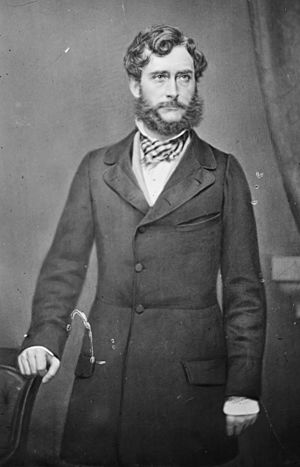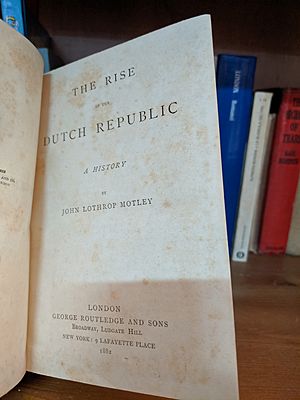John Lothrop Motley facts for kids
Quick facts for kids
John Lothrop Motley
|
|
|---|---|
 |
|
| United States Minister to the United Kingdom | |
| In office June 18, 1869 – December 6, 1870 |
|
| President | Ulysses S. Grant |
| Preceded by | Reverdy Johnson |
| Succeeded by | Robert C. Schenck |
| United States Minister to Austria | |
| In office November 14, 1861 – June 14, 1867 |
|
| President | Abraham Lincoln Andrew Johnson |
| Preceded by | Jehu Glancy Jones |
| Succeeded by | Henry M. Watts |
| Personal details | |
| Born |
John Lothrop Motley
April 15, 1814 Dorchester, near Boston, Massachusetts |
| Died | May 29, 1877 (aged 63) Dorchester, Dorset |
| Nationality | American |
| Occupation | Historian and diplomat |
| Signature | |
John Lothrop Motley (born April 15, 1814 – died May 29, 1877) was an American writer. He is best known for his popular history books, The Rise of the Dutch Republic and The United Netherlands. He was also a diplomat, a person who represents their country in other nations. He helped stop European countries from getting involved in the American Civil War on the side of the Southern states.
Contents
Early Life and Education
John Lothrop Motley was born on April 15, 1814, in Dorchester, Massachusetts. His family was well-known in Boston. His father, Thomas Motley, was a successful merchant. His mother, Anna Lothrop, came from a family of respected clergymen. Both parents cared a lot about John's education.
John went to the Round Hill School and Boston Latin School. He later graduated from Harvard in 1831. He spent his childhood in Dedham.
Studies in Germany
Motley also studied in Germany. He learned German language and literature at the University of Göttingen from 1832 to 1833. During this time, he became a close friend of Otto von Bismarck. Bismarck later became a very important leader in Germany.
Motley and Bismarck also studied law together in Berlin. Bismarck described Motley as having "a conversation sparkling with wit, humor or originality." He also noted Motley's "uncommonly large and beautiful eyes." After traveling in Europe, Motley returned to Boston in 1834 to continue his law studies.
Family and First Books
In 1837, John Motley married Mary Benjamin. She came from a wealthy Boston family. In 1839, he published his first novel, Morton's Hope, or the Memoirs of a Provincial. It was about life at a German university, based on his own experiences. The book was not very popular at the time. However, it is now known for showing a good picture of a young Bismarck.
In 1841, Motley briefly worked for the U.S. government in St. Petersburg, Russia. He resigned after three months because of the cold weather and high living costs.
A Career in Writing
After returning to Boston, Motley decided to focus on writing. He wrote several historical and critical essays for the North American Review magazine. These included "Life and Character of Peter the Great" (1845).
In 1849, he published his second novel, Merry Mount, a Romance of the Massachusetts Colony. This book was based on the unusual history of Thomas Morton and the Merrymount settlement.
Writing Dutch History
Around 1846, Motley began planning a history of the Netherlands. He wanted to write about the time of the United Provinces. He worked on this for a long time in the United States. However, he found that he needed more materials.
In 1851, he moved to Europe with his family. He spent the next five years in Dresden, Brussels, and The Hague. He researched old documents and archives. This hard work led to his famous book, The Rise of the Dutch Republic, published in 1856. The book became very popular and was translated into many languages.
In 1860, Motley published the first two volumes of his next work, The United Netherlands. This book was even more detailed and based on a lot of original research. Two more volumes were published in 1867, bringing the story up to the year 1609.
Diplomatic Service
In 1861, when the American Civil War began, Motley wrote two letters to The Times newspaper. He defended the Northern (Federal) side in the war. These letters were later printed as a pamphlet called Causes of the Civil War in America. President Lincoln was impressed by Motley's writing.
Partly because of this essay, President Lincoln appointed Motley as the United States minister to the Austrian Empire in 1861. This was an important job. Motley worked with other American diplomats to help prevent European countries from supporting the Southern states in the Civil War. He left this position in 1867.
Two years later, in 1869, he became the U.S. Ambassador to the United Kingdom. However, in November 1870, President Grant asked him to return home. Motley had upset Grant by not following instructions about a disagreement with Britain called the Alabama Claims.
After a short visit to the Netherlands, Motley returned to England. In 1874, he published another two-volume work, The Life and Death of John Barneveld, Advocate of Holland. This book also looked at the causes of the Thirty Years' War.
Later Life and Legacy
Motley's health began to decline, making it difficult for him to continue his writing. He passed away on May 29, 1877, in Kingston Russell House, near Dorchester, Dorset, England. He was buried in Kensal Green Cemetery in London.
John Lothrop Motley is remembered as an important historian and diplomat. His detailed histories of the Netherlands helped many people understand this important period in European history.
Selected Works
- Morton's Hope, or the Memoirs of a Provincial, 1839
- Life and Character of Peter the Great (North American Review), 1845
- Merry Mount, a Romance of the Massachusetts Colony, 1849
- The Rise of the Dutch Republic, 3 volumes, 1856
- History of the United Netherlands, 4 volumes, 1860–67
- Causes of the Civil War in America (from The Times), 1861
- Historic Progress and American Democracy, 1868
- The Life and Death of John of Barneveld, 2 volumes, 1874
See also
 In Spanish: John Lothrop para niños
In Spanish: John Lothrop para niños



